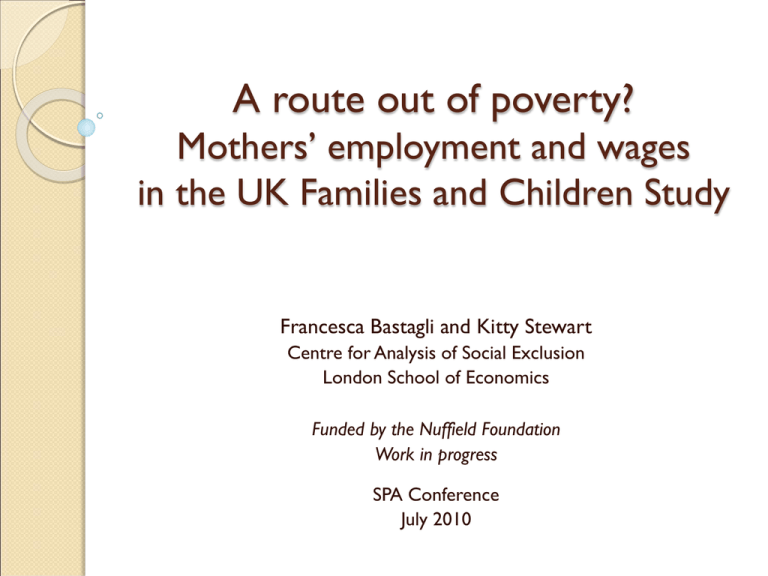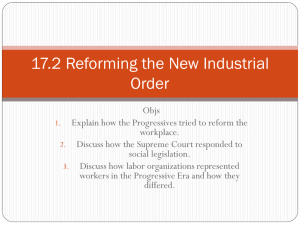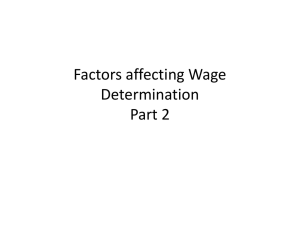employment and wage trajectories in
advertisement

A route out of poverty? Mothers’ employment and wages in the UK Families and Children Study Francesca Bastagli and Kitty Stewart Centre for Analysis of Social Exclusion London School of Economics Funded by the Nuffield Foundation Work in progress SPA Conference July 2010 Outline Motivation and questions The data Employment trajectories Wages Findings and discussion Motivation and questions UK government policy emphasises employment as a route out of poverty. “Getting a job, keeping a job and having the chance to progress up the earnings distribution out of low-paid work are the key to improving life chances” (HM Treasury, 1999). Mothers of young children encouraged to enter or return to work and to remain in paid work – through the tax credit system, childcare and labour market policies - to raise family income. For example: “In addition to assisting with employment retention, childcare can also promote career advancement. ...This will help to increase lone parent employment rates, decrease child poverty, reduce the gender pay gap and boost productivity” (Inter-departmental Childcare Review, 2002). Motivation and questions Do mothers: Enter and keep paid employment? Progress up the earnings distribution? Special attention paid to: Mothers of young children Low-skilled mothers The data UK Families and Children Study (FACS) Annual panel study of families with dependent children Sampled from Child Benefit records 1999-2005 - Wave 1-2: lone parents and low-income couples Wave 3 (2001) onwards: higher-income couples included to yield representative sample of British families with dependent children. Employment trajectories Employment trajectory sample sizes 2001-2005 Trajectory Frequency Percent Working FT stable 653 15.6 Working PT stable 664 15.8 Working stable PT-FT 555 13.2 No work stable 937 22.4 Exiters 212 5.1 Entrants 449 10.7 At home with one work episode 304 7.3 In and out 418 9.9 4192 100 Total Employment trajectories Examples of individual employment trajectories Yellow: not working; Pink: working full time; Blue: working part time Wages Hourly wage weekly wage/n. hours worked weekly Wage growth wgr= [wl – wf / wf] wgrw= wgr / y wl: last observed wage wf: first observed wage y: number of years between first and last observed wage Wages Median hourly wages: by trajectory and skill level Trajectory Median hourly wage Median hourly wage Low skilled Median hourly wage Skilled Working FT stable 6.9 5.9 8.4 Working PT stable 5.8 5.5 7.8 In and Out 5.7 5.2 8.0 Total 6.1 5.5 8.0 Source: FACS 2001-2005 Wages How does the final wage of mothers employed throughout the period compare with the final wages of mothers who moved in and out of work, controlling for starting conditions/initial wages? (Regressors in Model 2 include: age, own health, n of children, lone parent, tenure, new birth) OLS regression on final hourly wage (log). Model 1 Initial wage and work trajectories Model 2 + Personal and HH characteristics 0.45*** 0.43*** Working PT stable -0.09*** -0.11*** In and Out -0.11*** -0.14*** N R-squared 2122 0.27 2122 0.31 Initial wage (log) Trajectory – FT stable omitted Source: FACS 2001-2005 Wages Employment trajectory and final wage by skill level. OLS regression on final wage (log), includes personal and HH characteristics regressors (i.e. Model 2). Low skilled Skilled 0.33*** 0.44*** Working PT stable -0.05*** -0.15*** In and Out -0.11*** -0.14*** N R-squared 1462 0.18 656 0.31 Initial wage (log) Trajectory – FT stable omitted Source: FACS 2001-2005 Wage growth Hourly wage growth: by trajectory and skill level (weighted by N of years between first and last observed wage) Trajectory Wage growth Wage growth Sample Low skilled median Wage growth Skilled Working FT stable 4.7 4.3 5.3 Working PT stable 4.1 4.0 4.4 In and Out 3.4 3.3 4.1 Total 4.1 3.9 4.5 Source: FACS 2001-2005 Note: Percentage change in hourly earnings weighted by years (2001-2005) from Annual Survey of Hourly Earning (ASHE) for all employees: WOMEN: 4.8. Wage growth Probability for a working mother to experience: a) Wage growth above the sample median (4%) b) Negative wage growth. Dprobit on wage growth>=4%. Regressors: work trajectories, personal and HH characteristics. Full sample Low skilled Skilled Working PT stable -0.06** -0.03 -0.12*** In and Out -0.11*** -0.09** -0.13*** 2118 0.01 1462 0.01 656 0.03 Trajectory – FT stable omitted N Pseudo R-squared Source: FACS 2001-2005. Note: Table reports marginal effects. Wage growth Probability for a working mother to experience negative wage growth. Dprobit on wage growth<0. Regressors: work trajectories, personal and HH characteristics. Full sample Low skilled Skilled Working PT stable 0.11*** 0.07** 0.16*** In and Out 0.15*** 0.09** 0.24*** 2118 0.04 1462 0.03 656 0.06 Trajectory-FT stable omitted N Pseudo R-squared Source: FACS 2001-2005. Note: Table reports marginal effects. Findings 1. UK mothers follow a multitude of employment trajectories. Over the 1999-2005 period: 17% In and Out, 33% Mixed Enter/Exit/PT, vs 7% in FT stable employment. 2. Compared with working mothers in FT stable employment, mothers following interrupted pathways have lower final wages (controlling for initial conditions and changes in circumstances over time). 3. This difference is significantly higher among skilled women than for low skilled women; the “wage penalty” is higher among skilled mothers. Findings 4. Working mothers following interrupted work pathways are less likely (-11%) to experience a wage growth rate equal to or above the sample median. For skilled women the probability is -13%, while for low skilled women it is -9%. 5. Mothers on In and Out trajectories are more likely to record negative wage growth (15%) compared with those in FT stable employment. For skilled women, this probability reaches 24%, while for the low skilled it is 9%. Thank you. Francesca Bastagli: f.a.bastagli@lse.ac.uk Kitty Stewart: k.j.stewart@lse.ac.uk









